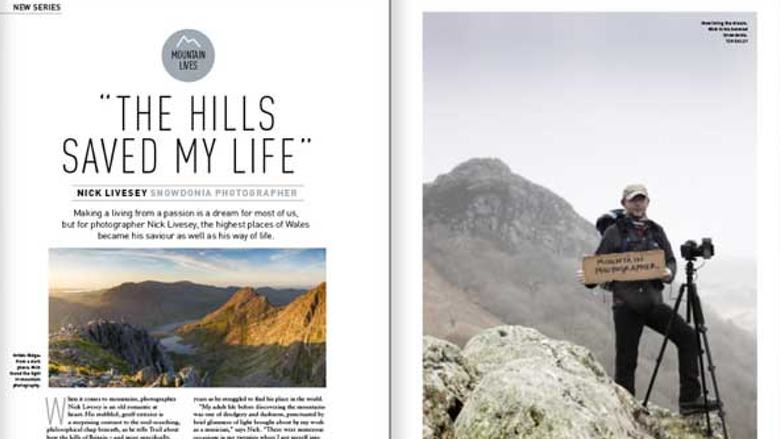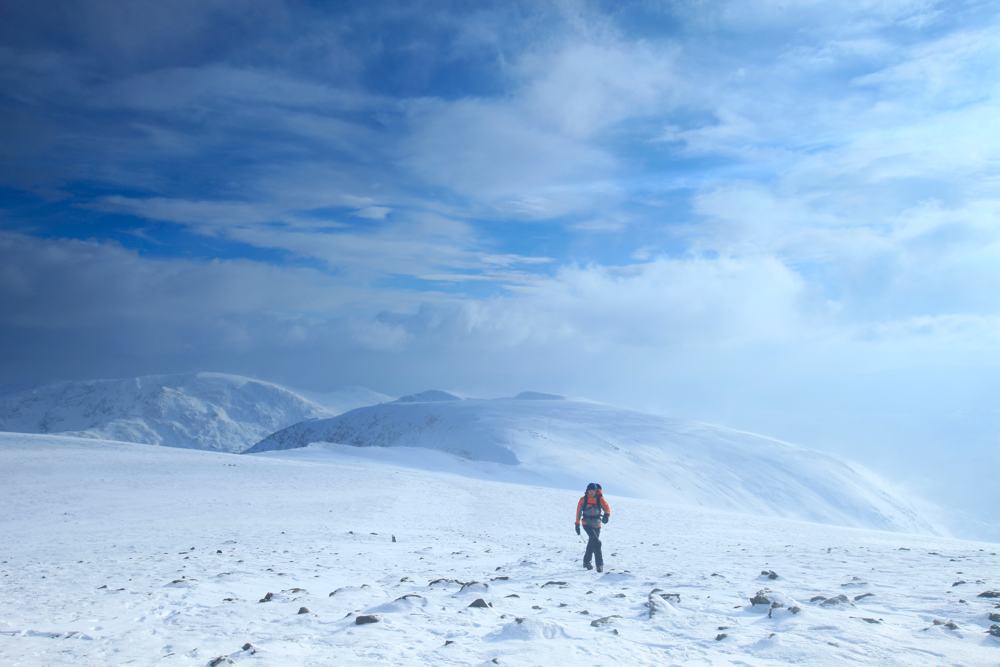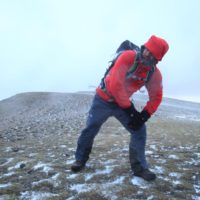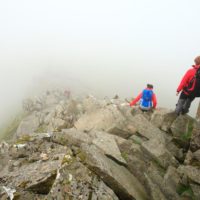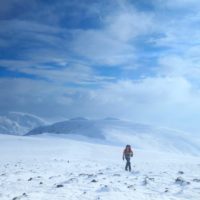The UK’s best-selling hillwalking magazine. Trail is packed with the latest kit, best routes and most inspiring adventures.
 TOG Says …
TOG Says …
“We are thrilled to have Trail Magazine on The Outdoor Guide sharing with our community their top hiking tips.”
Staying safe on Helvellyn
Want to climb Helvellyn but not sure where to start, when to go or what to wear? Start with this safety advice from Trail Magazine!
Helvellyn is the third highest mountain in England, and like all mountains in winter, conditions on its top are much more extreme than as sea level. Before heading out it’s important you have the right kit, the right skills and experience, and have checked the weather forecast before you go. Winter in the Lake District can bring anything from beautiful, benign frost to seriously deep snow, ice and and cornices – so it’s important you know what to expect, and turn around as soon as you start to feel out of your comfort zone.
Before you go, remember:
- Check the current conditions. Helvellyn is unique in that it has a daily update throughout winter provided by the Lake District Weatherline (www.lakedistrictweatherline.co.uk) This gives an excellent indication as to what weather conditions are like at the top of the mountain over the past 24 hours, and is invaluable when planning an ascent.
- Snow and ice require special care in the hills. If snow conditions are to be encountered on a mountain you may need extra equipment and skills to negotiate it safely. The best way to learn how to use these tools is a winter skills course; alternatively consider hiring a mountain instructor for the day, who will keep you safe, teach you lifelong skills and make your day much more fun! See the download below on the sort of skills you need to know, and find an instructor atwww.mountain-training.org
- Make sure you have the right gear for winter. Ice axes are essential for balance, traction and to arrest a fall if you slip.Crampons are spikes that attach to your boot to give you grip on hardened snow and ice. Stiff 3-4 season boots or 4 season boots are necessary to use these, and also for keeping your feet warm and kicking steps in snow. See the download below on the sort of kit you need for winter, and for summer.
- Conditions get worse the higher you go. If it’s snowy at the foot of the mountain, it’s likely to be much tougher up top. And if it isn’t snowy at the foot of the mountain, it doesn’t mean it won’t be higher up. Make sure you have waterproofs, warm clothing, food and drink and a head torch – and always tell someone where you are going.
- Daylight hours are shorter in winter. Climbing Helvellyn can take upwards of six hours, so depending on what time you start, you may be descending in the dark. Pack a headtorch, and a spare, plus extra layers for when it gets dark.
- Temperature decreases as you climb, by around 1 degree C every 100m. Climbing a 900m mountain this means if it’s 5 deg C at the bottom it will be well below freezing on the summit – and that’s before you take wind-chill into account! Always pack more clothing than you think you’ll need.
- Mountain rescue are volunteers, and are not a backup for the unprepared. But they would much rather be called out than not called out if someone is in danger. If you are lost, cold or injured, call 999 and ask for Cumbria Police, then mountain rescue. Give them as much information as you can about your location, the number in your party and details of the incident.
FAQ
Is Helvellyn hard to navigate?
Any mountain can be tricky to navigate if snow is on the ground, or if cloud makes it difficult for you to see what’s coming. Climbing any mountain you should be able to use a map and compass to work out where you are, and where to go. GPS units are fine but should never be a substitute for map and compass, as they can break or go wrong. Phones are useful too, but make sure you have software such as OS Maps or Viewranger with the appropriate OS Map loaded, and a back-up battery supply. Google Maps is no use!
When should I do it?
May to October is the best time to be out in the UK hills. You can get bad weather at any time of year, but if you’re inexperienced winter is best avoided, unless you’ve had special skills training and a familiar with ice axe and crampon use.
How steep is it?
Depends which route you take! If you ascend from the Thirlmere side from Swirls, it is steep but the terrain is relatively easy and the path is good, making it the quickest (an arguably the last interesting) way to ascend the mountain. If you ascend from Glenridding, you have a number of options. The usual route ascends the side of Keppel Cove, and is on a well-established path. It’s a straightforward with some steep ground higher up, but within the capabilities of most hillwalkers. For the adventurous, some of the Glenridding approaches can take you onto the ridges of Striding Edge and Swirral Edge – and these demand care and experience of scrambling and a good head for heights, as they sharpen to knife edge aretes in their higher reaches. They shoud not be attempted in high winds or if there is snow and ice on the ground, unless you have the skills and experience to handle it. If you are climbing a ridge with a teardrop-shaped lake beneath you and steep ground ahead, make sure you know where you are and where you’re going!
Am I experienced enough to try Striding Edge?
If it’s your first hillwalk, proceed with caution – or maybe leave it for next time. But if you’ve a good head for heights, are fit and the conditions are calm, dry and there’s no snow or ice on the ground Striding Edge is one of England’s greatest ridge walks! The best idea is to take an experienced pal with you, and remember the golden rule – never climb up anything you can’t climb back down again, and don’t be afraid to do so if you feel uncomfortable. The mountain will always be there, the trick is to make sure you are too!
Is there anywhere to buy food?
There are some local services in Glenridding and Patterdale, but nowhere to buy food on the mountain. Ensure you take plenty of high carb, high sugar food and at least 2 litres of water. Ensure you keep some of it back for emergencies.
Where can I park?
In the main car park in Glenridding on the mountain’s west side, or the car parks at Swirls and Wythburn on the A591.
Where’s the nearest pub?
The Traveller’s Rest in Glenridding is the closest you’ll get to a pub on the actual mountain! Otherwise on the east side there is the Rambler’s Bar at the Inn on the Lake, and the Glenridding Hotel. On the west (Thirlmere) side there is the King’s Head on the A591.
Find out more about Helvellyn including a picture gallery, routes, advice and a some interesting facts at livefortheoutdoors.com/Helvellynguide
Walking Tips
THE THREE MOST COMMON WALKING INCIDENTS & HOW TO AVOID THEM
Taking to the outdoors, whether on a big adventure or a regular stroll is not without its peril. It is, after all, a dangerous business stepping out your front door.
We all know about the dangers of rock falls and falling from heights. Such perils are self-evident.
Data from Mountain Rescue for England & Wales (MREW) shows that an increase in visitors results in an increase in accidents on the trails and hillsides. In fact, there were only 14 days in 2016 without a mountain rescue callout in England and Wales.
Nearly 500 incidents last year were of the type that lend themselves to being “easily avoided” compared to more serious medical issues or accidents. Such incidents include getting lost, benighted or cragfast, succumbing to minor slips and trips, or for some reason “unable to continue” all contribute to this figure.
So here’s a quick guide to the basics.
HOW TO AVOID… GETTING LOST
KNOW WHERE YOU’RE GOING
Before setting out for your walk or ride, plan your route and check any walking notes you can find. These will highlight topographical features and sights that will help guide your step. Make notes on a map with anything you want to remember, so you have the information to hand when you need it. Also, be generous with your timing so you have realistic ideas as to your resting points. This will give you plenty of time to get back if you do get sidetracked.
TAKE YOUR TIME
If you rush, you’re more likely to get lost. And what are you rushing for anyway? Take your time and enjoy the outdoors!
CRACK OUT A MAP
Intentionally getting lost is a noble pursuit, but if you don’t plan to get lost, there’s nothing wrong with breaking out a map and seeing where you need to go next. This does require map reading ability though… so make sure you learn how to read a map.
TRY GADGETS
Some people look down with scorn upon GPS trackers and other walking gadgets. But they can be very useful to people walking routes they haven’t done before. There’s nothing wrong with getting a little help from time to time!
HOW TO AVOID… BECOMING CRAGFAST
For the uninitiated, being crag-fast basically means getting stuck and it usually happens to climbers. It’s what happens when you can neither ascend nor descend from a crag.
PLAN YOUR ROUTE
The best way to avoid this is to take your time and plan your routes carefully. Don’t take chancy risks and try to think a couple of moves ahead. You can also get stuck in the dark. If you become benighted you can end up blundering into all sorts of hazards. So plan your timing carefully too.
REMEMBER, ANYONE CAN GET STUCK
Getting stuck doesn’t just happen to climbers. In fens, sand flats and other places where sudden rising water can cut you off, it can be easy to get stuck. In these places, make sure you do your research. Know when the tide will change and make sure you aren’t around when it does.
HOW TO AVOID…SLIPS & TRIPS
Stumbles and tumbles accounted for well over 50% of all accidents resulting in MREW call outs last year. From twisted ankles to broken pelvises, walkers can get into real trouble if they fall over.
WEAR THE RIGHT SHOES
This is a classic mistake new ramblers make. Make sure you’re wearing the right footwear for the job. If you’re walking over rough terrain, make sure you have lots of ankle support and decent grippy treads. If you’re going climbing, wear climbing shoes. They are specifically designed to help you climb, so they’re always worth the investment.
WATCH YOUR STEP!
The easiest way to not fall over is to avoid hazards in the first place. Always watch where you’re walking, particularly in craggy areas where loose rock and sudden small crevices are common. Again, take your time and choose your route carefully.
USE THE RIGHT PATH
Often, a park’s designated trail will be well marked and much easier to traverse than just marching across the wilds. It’s a safer route that is more likely to be regularly maintained by local groundskeepers and stewards.
It is not appropriate to demand or even expect incidents like this to disappear entirely; and nobody wants to see the wholesale discouragement of outdoor adventures. Nevertheless, it is this category of incidents where it is practical to suggest that improvements like these can be made in helping outdoor explorers to avoid getting into trouble through misadventure.
For more information visit: livefortheoutdoors.com/advice-stories/
#EverestAnywhere
Everest is 8848 metres tall. That’s 29,029ft – the cruising altitude of a 747, the bottom of the stratosphere… and several vertical miles higher than anything in Britain. A pretty epic challenge! But actually, if you add up all the ascent with every hill you climb, you could find that you’re on the way to reaching the height of the world’s highest mountain.
So why not take the Trail magazine challenge? Do it to get fit, do it for charity, do it to feel happier and healthier – but most of all, give yourself a goal to get out into our most beautiful places – the hills and mountains of Great Britain.
Find out how to here: livefortheoutdoors.com/everestanywhere



